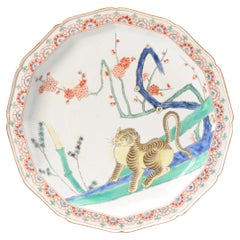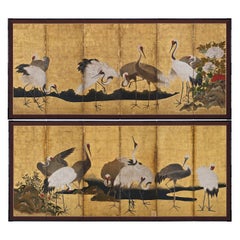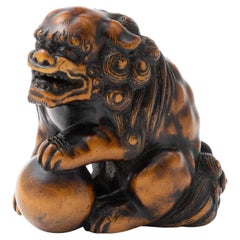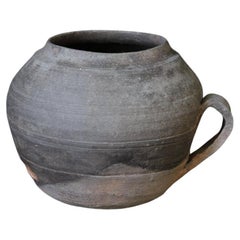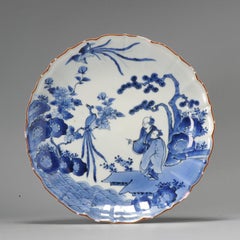Japanese Furniture
1
569
to
89
232
191
569
569
569
4
1
1
1
569
3,124
4,814
1,337
1,483
1,639
909
185
40
124
86
70
314
390
291
263
104
243
160
146
144
110
12,777
24,560
6,398
6,201
5,372
7
2
2
1
1
Period: 18th Century and Earlier
Place of Origin: Japanese
Antique Japanese Kakiemon Porcelain Tiger Plate, Top Quality Work Japan
Located in Amsterdam, Noord Holland
A lovely Kakiemon dish with Tiger
19th Century or earlier.
Condition
Perfect. Size 256 x 40mm diameter x height
Period
19th Century.
Category
17th Century Edo Antique Japanese Furniture
Materials
Porcelain
17th Century Japanese Screen Pair, Cranes
Located in Kyoto, JP
Cranes
Anonymous, Kano School.
Edo period, second half of the 17th century.
Pair of six-panel screens. Ink, pigment gofun and gold l...
Category
1670s Edo Antique Japanese Furniture
Materials
Gold Leaf
Large Wood Netsuke of a Shishi
Located in Milano, IT
Large wood netsuke of a shishi
Kyoto school, 18th/19th century
Height: 5.7cm
The large netsuke with a very nice patina, showing the mythical creatu...
Category
18th Century Antique Japanese Furniture
Materials
Wood
Samurai Mask with a Fierce Expression Ressei Menpo
Located in Milano, IT
Samurai mask with a fierce expression
Ressei Menpo
DATE Edo period (1615 - 1867), 18th century
A red lacquered high-level mask, with fierce (res...
Category
18th Century Antique Japanese Furniture
Materials
Iron
Sue Ware /Antique Japanese vase/4th-8th century/Wabi-sabi
Located in Kyoto-shi, Kyoto
This cup is an example of the type of stoneware known as Sue ware, produced from the middle of the fifth until the fourteenth century in Japan.
This produc...
Category
15th Century and Earlier Antique Japanese Furniture
Materials
Pottery
Edo Period 1680-1690 Japanese Porcelain Dish Kakiemon Figures Bird Animal Flo
Located in Amsterdam, Noord Holland
Sharing with you this very nice Edo period, 1680-1700, example. With a garden floral scene, figures and birds and a nice brown rim.
Marked at base with a Fuku mark.
Condition...
Category
18th Century Qing Antique Japanese Furniture
Materials
Porcelain
Japanese Six Panel Screen by Garden’s Edge
Located in Hudson, NY
Edo period (18th century) painting of a flowing array of various types of chrysanthemums painted on beautifully faceted heavy gold leaf and behind afinely painted fence. Petals of th...
Category
18th Century Antique Japanese Furniture
Materials
Gold
Set of Eight Antique Japanese Bird Paintings
Located in Palm Beach, FL
Rare and remarkable set of eight 18th century paintings of birds on silk executed with egg tempera in a delicate yet colorful style. Interesting historica...
Category
18th Century George III Antique Japanese Furniture
Materials
Silk, Paint
Shigaraki Tsubo Stoneware Ceramic Vessel
Located in Los Angeles, CA
Japanese ceramic vessel from Shiga, Japan. This piece gains its unique glaze and irregularities from the firing process in which wood is added...
Category
18th Century Edo Antique Japanese Furniture
Materials
Ceramic
Japanese Wabi-Sabi Small Antique Jar / Small Vase / Edo Period 1750-1850
Located in Sammu-shi, Chiba
It is a small jar that was burned in the latter half of the Edo period (1750-1850) in Japan.
It is "Shigaraki ware".
Shigaraki is a historic kiln located in Shiga prefecture, Jap...
Category
Late 18th Century Edo Antique Japanese Furniture
Materials
Pottery
16th Century Japanese Sculpture of a Buddhist Tenbu
Located in Hudson, NY
16th century Japanese sculpture of a Buddhist Tenbu, Late Momoyama period (1333-1598) sculpture dated "Bunroku 3", or 1594, in ink on the back. T...
Category
16th Century Antique Japanese Furniture
Materials
Metal, Gold Leaf
Japanese Antique Pottery Black Vase / Satsuma Ware / 1600-1800/Edo Period
Located in Sammu-shi, Chiba
This is a vase baked in Kagoshima prefecture in Kyushu called Satsuma ware in Japan. (The location of Satsuma ware is marked in red on the Japanese map.)
In general, Satsuma ware is well known for its luxurious decorations in various colors, but it is made for the upper class and for export.
This black Satsuma...
Category
17th Century Edo Antique Japanese Furniture
Materials
Pottery
Portuguese-colonial Japanese Namban lacquer Vargueno Cabinet, circa 1600
Located in Amsterdam, NL
A Portuguese-colonial Japanese Namban lacquer vargueno cabinet
Momoyama period, circa 1600
H. 43 x W. 64.5 x D. 36 cm
Wood, black lacquered and deco...
Category
Early 1600s Antique Japanese Furniture
Materials
Gold, Brass
Four magnificent 17th-century Japanese export gold lacquer Liquor or Gin bottles
Located in Amsterdam, NL
A set of four extremely rare and important pictorial-style Japanese export lacquer bottles
Edo-period, circa 1650-1680
H. 15.5 x W. 6.9 x B. 7.6 cm (each)
The bottles with red cop...
Category
Mid-17th Century Edo Antique Japanese Furniture
Materials
Copper, Gold, Silver
Pair of Japanese Edo Period Iron Silver Inlaid Red Lacquered Stirrups 'Abumi'
Located in New York, NY
A Pair of Japanese Edo Period (1603–1867) iron, silver inlaid, and red lacquered stirrups (Abumi). Each of typical form, made of iron with silver inlay on the front with floral bloss...
Category
1690s Edo Antique Japanese Furniture
Materials
Iron, Silver
Rare Charming 17th Century Japanese Lacquer Cabinet with Gilt-Bronze Mounts
Located in Amsterdam, NL
A fine Japanese pictoral style lacquer cabinet with gilt-metal mounts
Kyoto, Edo period, 1670-1690
Decorated in Japanese relief lacquer work, black lacquer ground decorated...
Category
Late 17th Century Antique Japanese Furniture
Materials
Bronze
Japanese Samurai Figure Hinaningyo, Edo Period
Located in Munich, Bavaria
Antique samurai doll called Hinaningyo; Japan, late EDO period
Praised at the Tang-no-sekku boys' festival on May 5th as a sign of bravery, embodying the...
Category
Mid-18th Century Antique Japanese Furniture
Materials
Textile, Wood
Japanese Wooden Buddhist Sculpture of Amida Nyorai, 16th Century
Located in Milano, IT
The Amitabha (Amida in Japanese) Buddha is shown standing with his hands forming the Amida raigo-in mudra. The face has a serene expression, with closed eyes under delicately arched brows and a severe face. The hair is arranged in rows of coils that also cover the "ushnisha", the protuberance on the head. The drapery is folded in elegant pleats falling from the shoulders to the feet. The antique sculpture is placed on a lotus flower which is located on a richly decorated base.
Faith in Amida Buddha remained largely confined to a small segment of the Japanese population until the Kamakura Era (1185-1333) when it was popularized by new Pure Land sects committed to bringing Buddhism to the illiterate commoner. These sects expressed concern for the salvation of the ordinary person and stressed pure and simple faith over complicated rites and doctrines. Amida Nyorai...
Category
16th Century Antique Japanese Furniture
Materials
Wood
Pair of 18th Century Japanese Imari Lidded Vases
Located in Brighton, Sussex
A very good quality pair of late 18th century Japanese lidded Imari vases. Each with Dog of foo gilded finials. Blue ground scrolling decoration, with i...
Category
Late 18th Century Antique Japanese Furniture
Materials
Porcelain
Japanese Six Panel Screen: Tosa School Painting of Theatre Scene
Located in Hudson, NY
with thought to be Izumo no Okuni (1578-1613). Mineral pigments and gold dust on mulberry paper with silk brocade border.
Category
18th Century Antique Japanese Furniture
Materials
Gold
Antique Brocade Kesa Monk's Patched Robe Edo Period
Located in Atlanta, GA
Kesa, known as "Jiasha" in Chinese and "Kasaya" in Sanskrit, is an out layer garment worn by the ordained Buddhist monks. Bearing a basic rectangular form, it developed originally in...
Category
Late 18th Century Edo Antique Japanese Furniture
Materials
Textile, Brocade
Japanese Antique Ancient Sueki Sue Ware Wabi-Sabi Pottery Vase Vessel Urn
Located in Studio City, CA
A wonderful, unique, and handcrafted piece of ancient Japanese Sueki Sue ware pottery dating back to the 500-600s (6th-7th century). Sueki/ Sue pottery was a ...
Category
15th Century and Earlier Folk Art Antique Japanese Furniture
Materials
Pottery, Stoneware
White China Fenix Figured Incense Burner, Edo Period
Located in Chuo-ku, Tokyo
Incense burner with three-dimensional molding of Hirado ware(Origin in Hirado, Nagasaki prefecture) of the Edo period.
Hirado ware is very famous for it...
Category
18th Century Antique Japanese Furniture
Materials
Porcelain
Pair of Fine Japanese Export Lacquer Cutlery Knife Boxes, 18th Century
Located in Amsterdam, NL
A pair of fine Japanese export lacquered cutlery boxes
Kyoto or Nagasaki, late 18th century
H. 33.5 x W. 24 x D. 21 cm
The bow-fronted boxes with sloping lids flat at the top are made of hinoki wood (Cypress), coated with Japanese paper and decorated in lacquer with scattered gold birds and flowers on a nashiji background. The Japanese mounts are made of copper and both boxes still have internal partitions to keep the cutlery upright.
The form of these boxes is similar to a pictorial-style knife box in the collection of the Groninger Museum (inv. 1989- 347), dated between 1730 and 1780, but the style of the decoration is more like that on a knife box in the Peabody Essex Museum in Salem (inv. E62271), which was brought to Salem by James Devereux, Captain of the Franklin, in 1799.
Provenance:
Henriette Jeane Christine van Neukirchen, called Nyvenheim (1807- 1849) and Nicolaas Johan Steengracht van Oostcapelle (1806-1866), thence by descent to the last owners, Ludolphine Emilie baronesse Schimmelpenninck van der Oye (1944) married in 1969 to Roland Daniel van Haersma Buma (1944), the last residents of castle Duivenvoorden near Voorschoten and the great-great-granddaughter of Nicolaas Johan Steengracht van Oostcapelle.
There is no evidence that Nicolaas Johan himself, or any of his or his wife’s ancestors had ever been in Japan. However, Nicolaas’ grandfather (Nicolaas Steengracht, 1754-1840) was a director of both the VOC and WIC (West Indies Company...
Category
Late 18th Century Antique Japanese Furniture
Materials
Silver
Japanese Ko-Seto Stoneware Ewer with Carved Design
Located in Atlanta, GA
On offer is a rare Ko-seto (old seto) stoneware ewer from Kamakura period (12-14th century) Japan. The exceptionally heavily potted ewer is made of stoneware. The main body was likely hand-coiled with individually built handle, sprout and wheel-made neck and mouth assembled. It takes the basic form from the contemporary Chinese ewer...
Category
15th Century and Earlier Archaistic Antique Japanese Furniture
Materials
Stoneware
Imari Porcelain With Hand-Painted Landscape design, Edo Period
Located in Chuo-ku, Tokyo
Imari ware made in the Arita area during the Edo period.
Gourd-shaped with a slender neck and mouth, it has a graceful appearance.
The style is reminiscent of Chinese Ming Dynasty paintings...
Category
18th Century Edo Antique Japanese Furniture
Materials
Porcelain
Pair of 18th Century Japanese Arita Imari Vases/Lamps
Located in Brighton, Sussex
A good quality pair of late 18th century Japanese Imari vases / lamps. Each with classical pagoda building, exotic flowers and birds, raised on out swepted ormolu bases.
Category
Late 18th Century Antique Japanese Furniture
Materials
Ormolu
Japanese Ao-Oribe Glazed Stoneware Dish, Early Edo Period, 17th Century, Japan
Located in Austin, TX
A fine and rare Japanese ao-oribe glazed minoyaki stoneware dish, late Momoyama or early Edo period, 17th century, Japan.
The circular dish of wheel thrown stoneware, glazed in the ...
Category
17th Century Edo Antique Japanese Furniture
Materials
Stoneware
18th Century Japanese Foliate Rimmed Bowl
Located in Atlanta, GA
18th century Japanese Kakiemon foliate rimmed bowl, Edo period (1603-1867). This charming bowl's decor shows a guardian lion ("shi shi") and a floral...
Category
18th Century Antique Japanese Furniture
Materials
Porcelain
Rare Japanese Sumi-E Lacquer Inro Yamada Jokasai Edo Period
Located in Atlanta, GA
A three-case lacquered Inro by Yamada Family circa 18th-19th century Edo period. The inro with slight rounded form is of Kano style and vividly depicts a dragon slithering among the ink clouds on a gold background. Sumi-e togidashi (ink togidashi) technique, in combination with Hiramaki-e, were employed to create the dreamy ambience of this piece. The dragon has a painterly appearance inspired by Chinese ink painting that was often seen on the Japanese folding screens. The back of the Inro was sparsely decorated with the shifting patterns of the darkening clouds with an emphasis on the space intentionally left empty. Jokasai was signed to the base. On the front of the inro there is another miniature signature Hakugyoku Hogen, which is one of names used by Kano Michinobu (1730-1790). The dragon is evidently one of his designs (see reference below).
Established by a member of Yamada family in the 17th century, the clan was one of the most prominent lacquer artisanal family for the next 200 years until the end of Edo period in the 19th century. Most members signed their work simply with Jokasai making the identification of the individual artists somewhat impossible. The current Inro on offer, compared to many other pieces by Jokasai, has an uncommon Kano style done in Sumi-e togidashi.
Another unusual feature of this piece is that the interiors of the inro was decorated with an interesting gold mosaic inlays (kirigane) on a dark lacquer background, giving it a jewel like quality.
For another Inro by Jokasai of a similar style using Sumi-e togidashi but depicts a tiger, see Wrangham collection, no.353, which was offered for sale as lot 256 in Bonham's London Auction: The Edward Wrangham Collection of Japanese Art Part I. 9 Nov 2010.
For an ink scroll...
Category
18th Century Japonisme Antique Japanese Furniture
Materials
Wood, Lacquer
Japanese Parcel Gilt Copper Hibachi, Edo Period, 18th Century, Japan
Located in Austin, TX
A sublime Japanese parcel gilt copper hand warmer, hibachi, with chrysanthemum design, Edo Period, 18th century, Japan.
The hand warmer, called a...
Category
18th Century Edo Antique Japanese Furniture
Materials
Copper
Japanese Six-Panel Screen Waterfall and Cherry in Audubon Landscape
Located in Hudson, NY
Japanese six-panel screen: waterfall and cherry in Audubon landscape, Edo period painting, 18th century, depicting summer and spring. A Kano Schoo...
Category
Mid-18th Century Edo Antique Japanese Furniture
Materials
Gold Leaf
Japanese Two Panel Screen: Gibbons in a Tree
Located in Hudson, NY
Ink painting on mulberry paper of gibbons in a tree with hints of gold in the sky.
Category
Early 18th Century Antique Japanese Furniture
Materials
Paper
Japanese Antique Pottery Jar / Beautiful and Rare Natural Glaze and Shape Jar
Located in Sammu-shi, Chiba
We have a unique Japanese aesthetic sense.
And only we can introduce unique items through our purchasing channels in Japan and the experience we have gained so far, in such a way th...
Category
15th Century and Earlier Other Antique Japanese Furniture
Materials
Pottery
Noh Edo Period Lion Mask II
Located in Pasadena, CA
This another superb example of an Edo Period early 18th century or earlier Lion Mask created for the Lion Dances of the Gion Matsuri Festival. The mask is i...
Category
Early 18th Century Edo Antique Japanese Furniture
Materials
Wood
Ca 17th C Japanese Ko-Imari Porcelain Edo Period Dish Antique Japan
Located in Amsterdam, Noord Holland
Description
Sharing with you a very nice example of the Edo period with a gentle scene of a bird in flight looking down on a garden scene with what seems to be a pot.
Condition...
Category
17th Century Antique Japanese Furniture
Materials
Porcelain
Japanese Six Panel Screen: Scenes in and Around Kyoto, 'Rakuchu Rakugai-Zu'
Located in Hudson, NY
The left two panels is the intersection of the Tokaido (an important and historical road that connects Kyoto with Tokyo) at Sanjo (Sanjo translates to "Third Street" and is the main ...
Category
18th Century Antique Japanese Furniture
Materials
Gold Leaf
Japanese Six Panel Screen Battle of Yashima from the Heike Monogatari
Located in Hudson, NY
Yamato-e painting depicting a great land and sea battle, the Battle of Yashima, March 22, 1185. The Heike were flushed from the mountainous and prote...
Category
18th Century Antique Japanese Furniture
Materials
Gold
Pair Antique Japanese Artia Ceramic Cabinet Plates
By Arita
Located in Atlanta, GA
A pair of Japanese decorative ceramic plates, made in Arita for export market circa 17-18th century. The cabinet-display dishes feature lotus-petal gilt rim and a lavish tricolor ene...
Category
18th Century Japonisme Antique Japanese Furniture
Materials
Ceramic
Ogata Kenzan Signed Japanese Asian Edo Period Pottery Tea Bowl Chawan
Located in Studio City, CA
A spectacularly designed and beautifully made Chawan tea bowl dating back to the Edo period. This work is attributed to Ogata Kenzan who is widely conside...
Category
18th Century Edo Antique Japanese Furniture
Materials
Pottery
Chinese Antique Shell-Inlaid Lacquer Tea Tool Box, Qing Period
Located in Chuo-ku, Tokyo
This is gorgeous and decorative instrument box decorated with "Raden" work of mother of pearl shell shining in seven colors. Raden work using mother of pearl shell shining in seven c...
Category
17th Century Qing Antique Japanese Furniture
Materials
Shell, Wood
Unusual 1660-1680 Japanese Porcelain Dish Bird Objects Kakiemon
Located in Amsterdam, Noord Holland
Description
Sharing this lovely little dish from the second half of the 17th century.
It is an Early Japanese Enamel Decorated Saucer c.1660-1680.
It is sometimes described as early Kakiemon or early Kutani, Dr.Oliver Impey describes this type as “early enamels”. The enamels on this saucer are deeply coloured and thick, the colours are rather striking.
Condition
2 small lines and a kintsugi filled chip. Size 100x20mm DiameterxHeight
Period
17th century Edo Period...
Category
17th Century Edo Antique Japanese Furniture
Materials
Porcelain
Antique Japanese Lacquer and Inlay Box from Ryukyu Island
Located in Atlanta, GA
A lacquer presentation box with mother-of-pearl inlays from Japanese Ryukyu Islands circa 17-18th century. The lidded box in rectangular form with rounded corner is a classic example...
Category
18th Century Japonisme Antique Japanese Furniture
Materials
Mother-of-Pearl, Lacquer
Pair Antique Ca 1680-1720 Japanese Imari Porcelain Vases Arita Edo Japan
Located in Amsterdam, Noord Holland
Description
A very nice example of two early Japanese Arita porcelain Lidded Vases teapot with floral, pagode and bird design. Lovely and delicate pair.
Condition
Overall Cond...
Category
18th Century Edo Antique Japanese Furniture
Materials
Porcelain
Japanese, Black Lacquer, Chrysanthemum Shaped Incense Burner 'Koro'
Located in Hudson, NY
With chrysanthemum motif and a gilded bronze lid. Includes unsigned collector's box. Interior measurements: 7 1/2" opening, 5 1/4" deep.
Category
Late 18th Century Antique Japanese Furniture
Materials
Lacquer
18th Century Japanese Hand-Carved Fully Blossomed Chrysanthemum Flower Figurine
Located in North Miami, FL
18th Century Japanese hand-carved fully blossomed chrysanthemum flower figurine made of white bone with branch and leaves painted. The flower is placed inside its original glass and ...
Category
18th Century Edo Antique Japanese Furniture
Materials
Bone
Japanese Six Panel Screen: Courtiers Festival
Located in Hudson, NY
Courtiers are those that are in attendance at a royal court. Beautifuly painted court figures in procession with ancient musical instruments. Tosa School painting in mineral pigments...
Category
Late 18th Century Antique Japanese Furniture
Materials
Gold Leaf
Japanese Two Panel Screen Suiboku Landscape in Sesshu Style
Located in Hudson, NY
Suiboku is a style of ink painting that is reminicent of the way calligraphers paint. Masterfully painted Muromachi Period (1336-1573) painting, unique in style and strength for the period with very bold lines. Sesshu Toyo...
Category
16th Century Antique Japanese Furniture
Materials
Silk, Paper
Important Japanese six-fold screen depicting The Tale of The Genji, 17th century
Located in Amsterdam, NL
An important Japanese six-fold screen, depicting episodes from The Tale of The Genji
Edo period, 17th century
Ink and colour on gilded paper, H. 155 x W. 380 cm
The Tale of Genji...
Category
17th Century Edo Antique Japanese Furniture
Materials
Paint, Paper
Japanese Two Panel Screen Bamboo in Early Snow
Located in Hudson, NY
Kano School painting, of the edge of a bamboo grove in early winter snow with very fine gold mist. Mineral pigments and gold dust on mulberry paper with 18th century brocade.
Category
18th Century Antique Japanese Furniture
Materials
Paper
17th century Japanese Porcelain Figural Jug Blue White Dish Antique
Located in Amsterdam, Noord Holland
Description
Sharing with you a very nice example of the Edo period. Made in Arita late 17th c. With sublime cobalt blue colours and painting. With figural garden landscape scene.
Condition
hairlines/chips/restoration to mouth. 2 chips (partly filled) to neck and body. Size 280x150mm HeightxDiameter
Period
17th century Edo Period...
Category
17th Century Meiji Antique Japanese Furniture
Materials
Porcelain
Japanese Screen Painting, circa 1700 'Horses' by Kano Tanshin
Located in Kyoto, JP
Horses
Kano Tanshin Morimasa (1653-1718)
Two-panel tea-ceremony Japanese screen or furosaki
Ink on gold leaf,
late 17th-early 18th century
Measures: H 55 cm x W 182 cm
The Kano school was closely aligned with the warrior class in Japan. The samurai, who lived in a closed and rigid hierarchical society established by the Shogunate, were drawn to the energy and freedom horses symbolize; Kano school artists commonly depicted the equine creatures as they are here, in unfettered and carefree family groups. China originally introduced horse paintings to Japan; the works typically focused on capturing the essence of horses in their various environments and often involved integrating human figures into the images.
Kano Tanshin Morimasa (1653-1718) was the son of Kano Tanyu...
Category
1690s Edo Antique Japanese Furniture
Materials
Gold Leaf
Japanese Bronze Incense Burner 'Koro'
Located in Hudson, NY
Wood storage box.
Category
18th Century Antique Japanese Furniture
Materials
Bronze
Japanese Two Panel Screen Pine and Red Sun on Gold
Located in Hudson, NY
Mineral pigments on gold leaf. Signature and seal read: Anei H-eishin Boshun ga, dated: late spring 1766 with a dedication to Okyo (Maruyama).
Category
Mid-18th Century Antique Japanese Furniture
Materials
Gold Leaf
Fine 17th Century Japanese Export Black and Gold Lacquered Pictorial-Style Dish
Located in Amsterdam, NL
A fine Japanese export black and gold lacquered pictorial-style dish Nagasaki or Kyoto, 1680-1720
The dish with wide flat rim of Keaki wood (Zelkova species) in black lacquer with...
Category
17th Century Edo Antique Japanese Furniture
Materials
Gold
Circa 1700 Japanese Screen Pair, Cranes & Pines, Kyoto Kano School
Located in Kyoto, JP
Pines and Cranes
Anonymous. Kyoto Kano School.
Late 17th/early 18th centuries, circa 1700.
Pair of six-panel Japanese folding screens.
Ink, gofun, pigment and gold leaf on paper.
This bold composition presents two pine trees extending to the left and right across a gold leaf background. One tree is silhouetted against a green ground, golden clouds obscuring its true size, the other stretches across a stylized waterway. The pines are paired with Manchurian cranes with red crests and snow white plumage. Both have been highly auspicious motifs in East Asia since Chinese antiquity. Here the artist utilized fluid and instinctive ink brushstrokes to define the trunk, branches and tail feathers, in strong contrast to the precision and sharp angularity of the crane’s legs and beaks. The adoption of this vast metallic painting support required an unerring sense of design and composition, so that the negative space surrounding motifs could imply context for the otherwise floating pictorial elements. The brushwork detailing the trunks of the pines, the exaggerated dimensions of the pine trees and the strength and dynamism of the composition are all reminiscent of Kano Eitoku...
Category
Late 17th Century Edo Antique Japanese Furniture
Materials
Gold Leaf
Japanese Six Panel Screen: Karako 'Chinese Children'
Located in Hudson, NY
Children at play in a Chinese palace garden, a favorite subject of Japanese painters. Kano School painting in mineral pigments on mulberry paper with si...
Category
18th Century Antique Japanese Furniture
Materials
Bronze
Large Japanese Lacquer Box Early Edo Period Ex-Christie's
Located in Atlanta, GA
A large lacquer Ryoshibako (Paper box in Japanese) finely decorated with Maki-e circa 17th century early Edo period. The box is of an impressive size and was used to store paper documents. Both sides of the lid were elaborately decorated with maki-e and the edge was befitted with lead rim, an early practice before the silver rim became common later. The interior and base were finished in Nashiji. The night scene on top surface of the lid depicts flocks of chidoris flying in formation from a sea shore swaying with reeds under a full moon, using hiramaki-e in both gold and silver. Ribbons of clouds were achieved with different densities of gold powder. The underside, in contrast, shows a crescent moon in takamakie-e above the sea with ferns and reeds. Chidoris, the plovers, are symbolic in Japanese culture as "thousands of blessings" and longevity. The Namichidori, the pattern in which the chidori flies in the nami (wave) represents the eternal love and safety of couples and families. For detailed references on the historical background and the use of chidoris on lacquerware, see the reference below.
This very lacquer box was featured for sale as lot 339 in Christie's London Sale Japanese Art...
Category
17th Century Japonisme Antique Japanese Furniture
Materials
Wood, Lacquer
Recently Viewed
View AllMore Ways To Browse
Cabinet With Stepped Doors
Washed Cabinet
Vintage Corner Shelf
Walnut Inlaid Commode
George Iii Mahogany Chest Of Drawers
White Marble Top Commode
Bedside Tables Chests
Antique White Interior Paint
Century Furniture 4 Drawer Chest
Leaded Door
Boat In A Case
White Marble Top Chest Of Drawers
Bedside Table And Chest
Bow Fronted Chest
Bow Front Chest
White Retro Chest Of Drawers
Vintage Four Roses
White French Provincial Furniture
